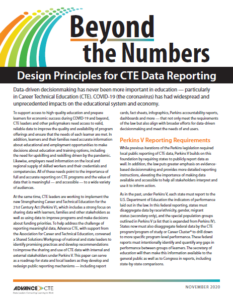Sir Arthur Conan Doyle’s Sherlock Holmes once famously said “It is a capital mistake to theorize before one has data. Insensibly one begins to twist facts to suit theories, instead of theories to suit facts.” Without access to reliable, high-quality and timely data, it is impossible for learners, families, industry representatives, practitioners and policymakers to make informed decisions about CTE program development, improvement or participation.
The Strengthening Career and Technical Education for the 21st Century Act (Perkins V) pushes states to improve the public accessibility of Career Technical Education (CTE) data. According to the law, state agencies, as well as local recipients, must share data on the performance of all CTE students, and subgroups of learners, and make this information available widely and through a variety of user-friendly formats.
But judging by the current state of CTE reporting, states have a lot of work to do to make CTE data accessible and actionable to a broad audience. Some of the challenges of state CTE reporting include:
- Burying CTE data deep in an agency website or behind a firewall
- Reporting out static data in tables with little to no interpretation
- Using CTE jargon that is meaningless to members of the public
Many of the current CTE reporting challenges result from a lack of time and intentionality, but the good news is that Perkins V gives states an opportunity to hit restart and reimagine their approach to public reporting and communication with a focus on accessibility and understanding. In March, Advance CTE and the Association for Career and Technical Education (ACTE) convened a Shared Solutions Workgroup of state and national experts to explore strategies for effective CTE data reporting and communication. Over a series of meetings, the workgroup co-designed a set of tools and resources to help states improve their CTE data reporting.
CTE Reporting Tools Should Draw From Best Practices for Design and Usability
 State leaders can look to best practices in data visualization and accessibility to ensure their CTE reporting tools are widely accessible and equip users to make the most of the data.
State leaders can look to best practices in data visualization and accessibility to ensure their CTE reporting tools are widely accessible and equip users to make the most of the data.
The report Beyond the Numbers: Design Principles for CTE Data Reporting provides nine principles for developing effective and accessible CTE data reporting tools:
- Clarify the purposes for sharing data
- Make data easy to find
- Make data visually appealing
- Clearly and consistently label and describe data
- Make data accessible
- Disaggregate data to highlight equity
- Provide context to add meaning
- Enable interactivity and customization for key audiences
- Help users interpret data and take action
State and local leaders can use these design principles as a blueprint to inform the early design and development of CTE data reporting tools or as a checklist to ensure their final reports align with best practices for access and usability.
States Should Develop a Plan to Communicate CTE Data
 Effective data reporting, however, requires not just well-designed and accessible reports but also a strategy to build understanding among the general public and key stakeholders. What good is data if it isn’t used? Yet state CTE offices are asked to attend to multiple priorities — from program review to professional development to equity monitoring — and communicating CTE data all too often is moved to the backburner.
Effective data reporting, however, requires not just well-designed and accessible reports but also a strategy to build understanding among the general public and key stakeholders. What good is data if it isn’t used? Yet state CTE offices are asked to attend to multiple priorities — from program review to professional development to equity monitoring — and communicating CTE data all too often is moved to the backburner.
Beyond the Numbers: A Toolkit for Communicating CTE Data is designed to build state capacity for communicating CTE data and integrating compelling CTE statistics into a broader CTE communications plan. The toolkit breaks down six steps for communicating CTE data, from identifying a strategic goal and audience, to creating materials, to building an action plan. The toolkit also includes models and templates states can use to build engaging infographics, presentations and other materials to communicate their data.
Effective Data Reporting Takes Time — States Should Plan Ahead
States have a long runway to prepare for Perkins V reporting. They are not required to submit data on CTE performance to the U.S. Department of Education until next year, and many states will not publicly report Perkins V data to stakeholders until after that time.
Still, it takes time to design, develop and invest in high-quality and effective CTE data reports and tools. State leaders should be thinking about their approach to CTE data reporting now so they have the tools and resources ready to share with key stakeholders when the time comes. Until then, states can refer to the design principles and communications toolkit to draw on best practices for their CTE reporting and communications strategies.
Advance CTE would like to acknowledge the support of ACTE, Next Chapter Communications and the CTE Data Reporting and Visualization Shared Solutions Workgroup in the development of these materials. These resources were produced with funding from the Bill & Melinda Gates Foundation.
Austin Estes, Manager of Data & Research, Advance CTE
